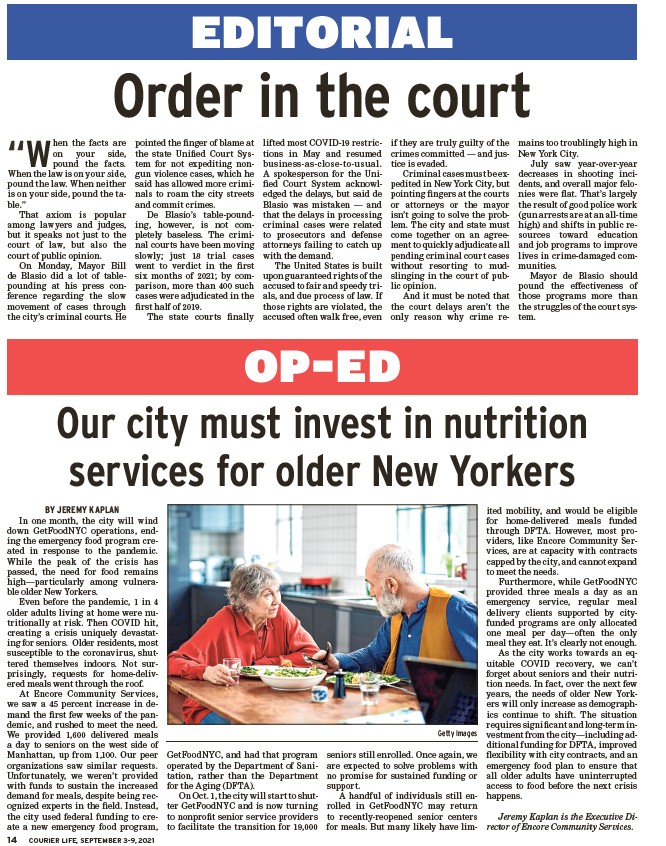
Order in the court
Our city must invest in nutrition
services for older New Yorkers
COURIER L 14 IFE, SEPTEMBER 3-9, 2021
EDITORIAL
OP-ED
“When the facts are
on your side,
pound the facts.
When the law is on your side,
pound the law. When neither
is on your side, pound the table.”
That axiom is popular
among lawyers and judges,
but it speaks not just to the
court of law, but also the
court of public opinion.
On Monday, Mayor Bill
de Blasio did a lot of tablepounding
at his press conference
regarding the slow
movement of cases through
the city’s criminal courts. He
pointed the fi nger of blame at
the state Unifi ed Court System
for not expediting nongun
violence cases, which he
said has allowed more criminals
to roam the city streets
and commit crimes.
De Blasio’s table-pounding,
however, is not completely
baseless. The criminal
courts have been moving
slowly; just 18 trial cases
went to verdict in the fi rst
six months of 2021; by comparison,
more than 400 such
cases were adjudicated in the
fi rst half of 2019.
The state courts fi nally
lifted most COVID-19 restrictions
in May and resumed
business-as-close-to-usual.
A spokesperson for the Unifi
ed Court System acknowledged
the delays, but said de
Blasio was mistaken — and
that the delays in processing
criminal cases were related
to prosecutors and defense
attorneys failing to catch up
with the demand.
The United States is built
upon guaranteed rights of the
accused to fair and speedy trials,
and due process of law. If
those rights are violated, the
accused often walk free, even
if they are truly guilty of the
crimes committed — and justice
is evaded.
Criminal cases must be expedited
in New York City, but
pointing fi ngers at the courts
or attorneys or the mayor
isn’t going to solve the problem.
The city and state must
come together on an agreement
to quickly adjudicate all
pending criminal court cases
without resorting to mudslinging
in the court of public
opinion.
And it must be noted that
the court delays aren’t the
only reason why crime remains
too troublingly high in
New York City.
July saw year-over-year
decreases in shooting incidents,
and overall major felonies
were fl at. That’s largely
the result of good police work
(gun arrests are at an all-time
high) and shifts in public resources
toward education
and job programs to improve
lives in crime-damaged communities.
Mayor de Blasio should
pound the effectiveness of
those programs more than
the struggles of the court system.
BY JEREMY KAPLAN
In one month, the city will wind
down GetFoodNYC operations, ending
the emergency food program created
in response to the pandemic.
While the peak of the crisis has
passed, the need for food remains
high—particularly among vulnerable
older New Yorkers.
Even before the pandemic, 1 in 4
older adults living at home were nutritionally
at risk. Then COVID hit,
creating a crisis uniquely devastating
for seniors. Older residents, most
susceptible to the coronavirus, shuttered
themselves indoors. Not surprisingly,
requests for home-delivered
meals went through the roof.
At Encore Community Services,
we saw a 45 percent increase in demand
the fi rst few weeks of the pandemic,
and rushed to meet the need.
We provided 1,600 delivered meals
a day to seniors on the west side of
Manhattan, up from 1,100. Our peer
organizations saw similar requests.
Unfortunately, we weren’t provided
with funds to sustain the increased
demand for meals, despite being recognized
experts in the fi eld. Instead,
the city used federal funding to create
a new emergency food program,
GetFoodNYC, and had that program
operated by the Department of Sanitation,
rather than the Department
for the Aging (DFTA).
On Oct. 1, the city will start to shutter
GetFoodNYC and is now turning
to nonprofi t senior service providers
to facilitate the transition for 19,000
seniors still enrolled. Once again, we
are expected to solve problems with
no promise for sustained funding or
support.
A handful of individuals still enrolled
in GetFoodNYC may return
to recently-reopened senior centers
for meals. But many likely have limited
mobility, and would be eligible
for home-delivered meals funded
through DFTA. However, most providers,
like Encore Community Services,
are at capacity with contracts
capped by the city, and cannot expand
to meet the needs.
Furthermore, while GetFoodNYC
provided three meals a day as an
emergency service, regular meal
delivery clients supported by cityfunded
programs are only allocated
one meal per day—often the only
meal they eat. It’s clearly not enough.
As the city works towards an equitable
COVID recovery, we can’t
forget about seniors and their nutrition
needs. In fact, over the next few
years, the needs of older New Yorkers
will only increase as demographics
continue to shift. The situation
requires signifi cant and long-term investment
from the city—including additional
funding for DFTA, improved
fl exibility with city contracts, and an
emergency food plan to ensure that
all older adults have uninterrupted
access to food before the next crisis
happens.
Jeremy Kaplan is the Executive Director
of Encore Community Services.
Getty Images